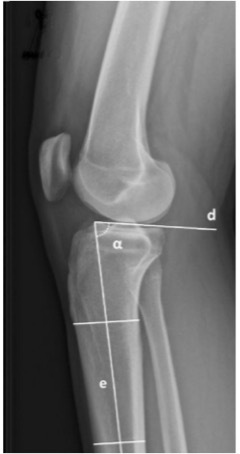
Side‐to‐side anterior tibial translation on monopodal weightbearing radiographs as a sign of knee decompensation in ACL‐deficient knees
31/08/2021
Macchiarola L., Jacquet C., Dor J., Zaffagnini S., Mouton C., Seil R. Side-to-side anterior tibial translation on monopodal weightbearing radiographs as a sign of knee decompensation in ACL-deficient knees. Knee Surg Sports Traumatol Arthrosc. 2021 Aug 30. doi: 10.1007/s00167-021-06719-0. Epub ahead of print. PMID: 34459934.
Abstract
Purpose: To evaluate the influence of time from injury and meniscus tears on the side-to-side difference in anterior tibial translation (SSD-ATT) as measured on lateral monopodal weightbearing radiographs in both primary and secondary ACL deficiencies.
Methods: Data from 69 patients (43 males/26 females, median age 27-percentile 25-75: 20-37), were retrospectively extracted from their medical records. All had a primary or secondary ACL deficiency as confirmed by MRI and clinical examination, with a bilateral weightbearing radiograph of the knees at 15°-20° flexion available. Meniscal status was assessed on MRI images by a radiologist and an independent orthopaedic surgeon. ATT and posterior tibial slope (PTS) were measured on the lateral monopodal weightbearing radiographs for both the affected and the contralateral healthy side. A paired t-test was used to compare affected/healthy knees. Independent t-tests were used to compare primary/secondary ACL deficiencies, time from injury (TFI) (≤ 4 years/ > 4 years) and meniscal versus no meniscal tear.
Results: ATT of the affected side was significantly greater than the contralateral side (6.2 ± 4.4 mm vs 3.5 ± 2.8 mm; p < 0.01). There was moderate correlation between ATT and PTS in both the affected and healthy knees (r = 0.43, p < 0.01 and r = 0.41, p < 0.01). SSD-ATT was greater in secondary ACL deficiencies (4.7 ± 3.8 vs 1.9 ± 3.2 mm; p < 0.01), patients with a TFI greater than 4 years (4.2 ± 3.8 vs 2.0 ± 3.0 mm; p < 0.01) and with at least one meniscal tear (3.9 ± 3.8 vs 0.7 ± 2.2 mm; p < 0.01). Linear regression showed that, in primary ACL deficiencies, SSD-ATT was expected to increase (+ 2.7 mm) only if both a meniscal tear and a TFI > 4 years were present. In secondary ACL deficiencies, SSD-ATT was mainly influenced by the presence of meniscal tears regardless of the TFI.
Conclusion: SSD-ATT was significantly greater in secondary ACL deficiencies, patients with a TFI greater than 4 years and with at least one meniscal tear. These results confirm that SSD-ATT is a time- and meniscal-dependent parameter, supporting the concept of gradual sagittal decompensation in ACL-deficient knees, and point out the importance of the menisci as secondary restraints of the anterior knee laxity. Monopodal weightbearing radiographs may offer an easy and objective method for the follow-up of ACL-injured patients to identify early signs of soft tissue decompensation under loading conditions.
